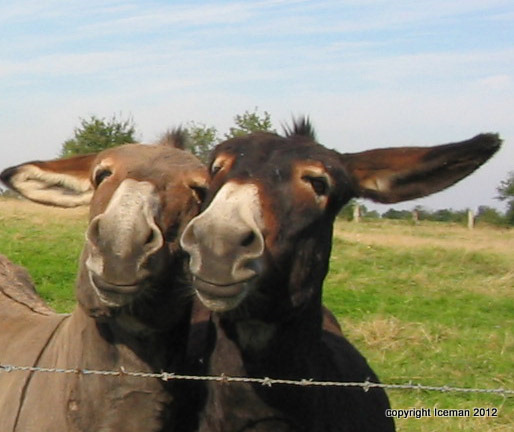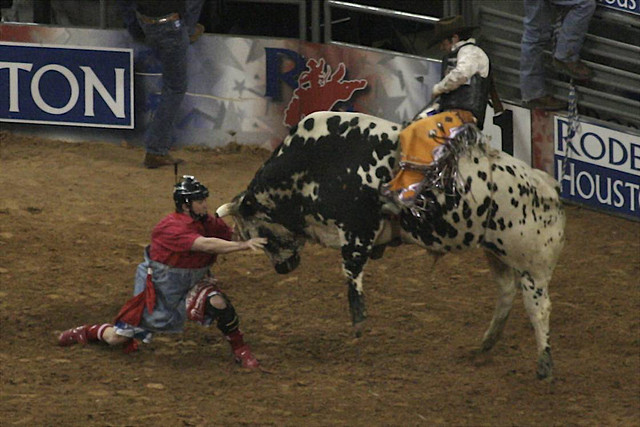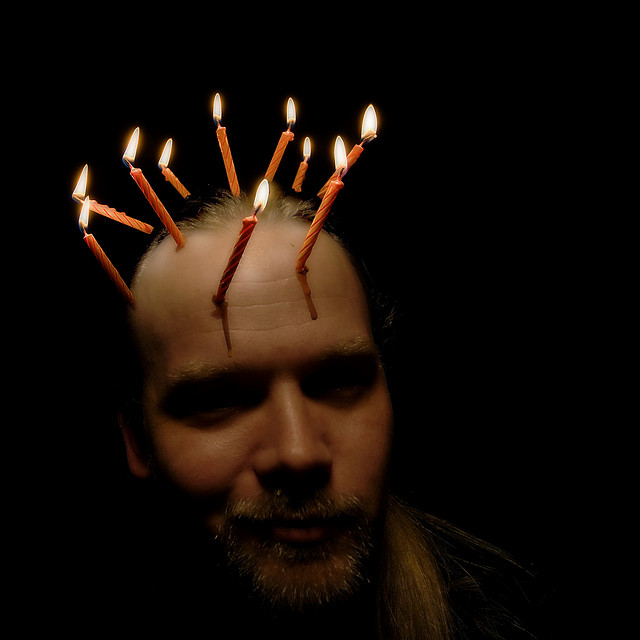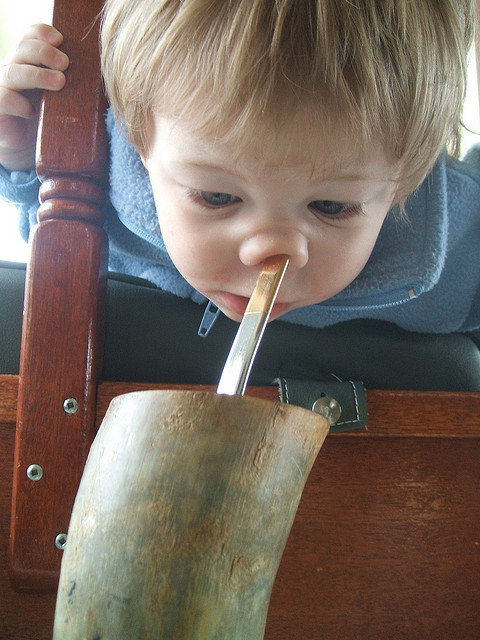The Special People That Believe in You
 Companies don’t need more ideas, they need ideas that are more meaningful. Companies have plenty ideas because they measure and track the number of new ideas generated. Enter your idea on the company’s open innovation web portal, and you’re done. Let the record show that a new idea was added to the hopper. Increment the counter and update the metrics. One new idea for the good guys. It’s a good day to be alive.
Companies don’t need more ideas, they need ideas that are more meaningful. Companies have plenty ideas because they measure and track the number of new ideas generated. Enter your idea on the company’s open innovation web portal, and you’re done. Let the record show that a new idea was added to the hopper. Increment the counter and update the metrics. One new idea for the good guys. It’s a good day to be alive.
For some reason leaders are comforted by a large number of new ideas in the hopper even though there’s no hope of working on them. Maybe they think there’s value in a backlog of ideas they can fall back on if the existing work doesn’t pan out. If that’s the case, they probably think the ideas in the hopper have good potential. But because the ideas are not graded on their potential, that’s simply wishful thinking.
The only thing good about counting the number of new ideas is that the number of new ideas is easy to count. The good thing about grading ideas on their level of meaningfulness is it causes the most meaningful ideas to rise to the top. The bad thing about grading ideas is that it requires judgement. And today, judgment is in short supply. If you use your judgement poorly your career suffers, but if you avoid using your judgement no one notices. Here’s a rule: If you never you use your judgement, you can never use it poorly.
For a select few, any work that doesn’t require judgment doesn’t rise to the level of work worth doing. For them, only the most meaningful work will do, and rolling the dice on their career is simply the cost of doing business. For them, it’s judgement or bust.
If you use your judgement and choose to work on a meaningful idea, be prepared for the loneliness. Meaningful ideas are, by definition, understood by a few and misunderstood by the rest. It’s lonely to advance an idea that most don’t understand. And prepare to be misjudged for your actions because your steadfast pursuit of the idea will also be misunderstood. Your vigor and aliveness will be seen as aggressiveness, anger, negativity, closemindedness, or political incorrectness. But this misjudgment comes with the territory. There’s no way around it. It’s just how it goes. It’s not personal.
But just as the trivial many will try to tear you down, there are a vital few who will praise you, support you and bolster you. These are the special people in your organization. You know who I’m talking about. You have a personal relationship with them. You know about their families. You’ve been through tough times together. They’ve seen you struggle, stumble and tumble, and they’ve seen you get up and move forward. They’ve seen you run into a brick wall and helped you back to your feet. Don’t dismiss their praise and don’t feel guilty about accepting help from them. They don’t want credit for helping you, they want you to succeed.
You don’t know this, but those special people want to help you because you’ve already helped them. Some time ago you unknowingly helped them through a tough time, or were kind to them. Or, you invested in them or believed in them. More than likely, though, you inspired them.
Keep moving forward. Keep pushing. And take comfort from the special people that believe in you.
Image credit – Ice Man
Ideas That Threaten
 Every idea that’s worth its salt will be rejected out of hand. That’s just how it is. You can get angry because you didn’t get the support you think you deserve or you can accept the fact that their negative reaction is about them. The first way you shut down and your idea dies on the vine. The second way you let their negativity pass right through you and continue your uphill slog until your idea is commercialized. Either way, it’s your choice.
Every idea that’s worth its salt will be rejected out of hand. That’s just how it is. You can get angry because you didn’t get the support you think you deserve or you can accept the fact that their negative reaction is about them. The first way you shut down and your idea dies on the vine. The second way you let their negativity pass right through you and continue your uphill slog until your idea is commercialized. Either way, it’s your choice.
It’s difficult to let others’ negativity pass though you. It may be easier to flip the situation on its head.
When confronted with an exceptional idea, people generate a negative response. The underlying feeling is fear, but usually manifests as aggressive dismissal. Instead of reacting with anger, maybe you can learn to see their fear-based reaction as a signifier of significance. When you have a tooth with a cavity and you drink cold water, your tooth creates a reactionary zing of electrical energy, a tell-tale sign of the underlying decay. The zing signifies the significance. Just as the cold water elicits an electrical response from the cavity, the exceptional idea elicits a negative response from the person. Don’t worry about the negative response, revel in it.
The only thing better than an idea that is so good it threatens is an idea that’s so good no one can understand. These ideas are so deep, no novel, so twisted they conflict with conventional wisdom. These ideas confuse everyone, especially the experts. At first the experts aren’t threatened because they don’t yet understand. They chuckle and take pity on you for thinking such strange thoughts. Just as a negative reaction indicates significance, their chuckles and pity are leading indicators of significance. Don’t let their reactions deter you, let them inspire you. As your unconventional wisdom seeps into them and they begin to understand, their chuckles will morph into aggressive dismissal. This tell-tale sign makes it clear you’re on to something.
If your idea doesn’t get a negative reaction, you’re not trying hard enough. Think bigger. If your idea doesn’t threaten your most profitable product, come up with one that does. If your idea doesn’t shake the fillings out of your business model, go away and don’t come back to you have one that does.
Companies don’t need more ideas, they need ideas that are more creative. They don’t need more continuous improvement, they need more discontinuous improvement. And they don’t need ideas that build on success, they need ideas that dismantle it.
If your ideas don’t threaten, don’t bother.
Image credit — Ed Schipul
Celebrating Six Years of Blog Posts
 Today marks six years of blog posts published every Wednesday evening. 300 weeks in a row and I haven’t skipped, forgot, or repeated. All written without an editor, though you knew that by the typos and grammar stumbles.
Today marks six years of blog posts published every Wednesday evening. 300 weeks in a row and I haven’t skipped, forgot, or repeated. All written without an editor, though you knew that by the typos and grammar stumbles.
It’s a challenge to write every week, but it’s worth it. Writing demands thinking things through, which can be difficult especially if you want to write clearly, but thinking things through creates knowledge. Deep knowledge.
Over the last year I wrote a lot about self-awareness, mindfulness and intentions. I’m better for my meditations, and through osmosis, so are some of the people closest to me. I expect you’ll hear more on these themes over the next year.
I’ve put myself out there with my writing. With some posts I’m afraid to hit the publish key, and those are the posts that matter. My fear is the signal there’s something important in the post. I hope to write more of those.
I strive to write clearly and densely and avoid buzzwords. Innovation is the buzzword that trips me up. But like He-Who-Shall-Not-Be-Named, I’ll see if I can avoid calling it by name. (And never three times in the same post.) And my call-to-arms will be clearer, plainer, denser.
I’m not sure what next year will bring, but I hope it will be 52 more posts.
Thanks for reading.
Mike
Image credit – Bart.
The cards don’t matter. What matters is how you play them.
 What you think of yourself colors everything you do. When someone challenges your ideas, your response makes it clear how you see yourself. Regardless of your response, you tip your hand. Regardless of your response, everyone can see your cards.
What you think of yourself colors everything you do. When someone challenges your ideas, your response makes it clear how you see yourself. Regardless of your response, you tip your hand. Regardless of your response, everyone can see your cards.
When you have a terrible poker hand like, say, a king high, you can respond three ways. You can fold and let the challenger go unchallenged. You can check and kick the can down the road. Or you can bluff and go toe-to-toe with the challenger. With the fold you see things as they are and behave accordingly. The fold is an admission you have a lesser hand. And sometimes that’s difficult to do. The check says you don’t want others to know you have a terrible hand but you thing things will turn around. With the bluff you pretend things are different than they are and you pretend accordingly. You may fool the unseasoned player on your right, but make no mistake, the card shark on your left knows you’re bluffing. And deep down, you know too.
With a middle-of-the-road hand like the full house you have the same options. The fold is less likely because your hand is stronger. You fold only when you sense a strong challenge and the pot is large. No sense going head-to-head with a player with swagger when the stakes are high. There’s no harm in folding. The check says you’re not sure of yourself, or, you are and your hand is neither special nor terrible. The bluff is still risky but less so. If you think you can survive getting caught and are okay with the follow-on judgement, there’s a larger probability you’ll try.
With four aces you call the shots. The fold is reserved for those special situations where you want to preserve the status of players you care about. Or, when you have enough chips and you want others to get the glory. Either way it’s too little used. Few have the self-worth, generosity and thoughtfulness to play things that way. The check is equally generous. The check says you’re comfortable with your cards and how the hand is going. No need to flex your muscles. When you have the winning cards the bluff is counterproductive. Playing bigger than your hand pushes everyone away and they fold. You may with the pot, but next hand they’ll go after you. Embarrassing the other players is no way to play.
Really, though, your cards don’t matter. Regardless of your cards, don’t take a challenge personally. Regardless of your cards, respond like you hold all of them – all the aces, face cards, and all the wild cards.
It relatively easy to behave this way when the professional challenges your ideas because they don’t challenge you, they challenge your ideas. And you are not your ideas. Look deeply and honestly at the ideas and leave your self out of it. But it’s more difficult with the hack. Under the banner of challenging your ideas, the hack will try to challenge you. Here’s where you’ve got to hold onto a fundamental truth – no one can challenge you without your consent. Here’s where you’ve got to remember this truth applies to everyone – those with a four-of-a-kind, those with a full house, and those with a pair of twos. Here’s where you’ve got to remember that your cards don’t matter. The best way I know how to do that is to visualize your self as a screen door and let their hot air pass through you.
The challenges don’t matter and neither does the hand you were dealt. All that matters is your response. Respond with your heart’s best intentions and everyone will split the pot and they’ll want you to deal every hand.
Image credit – lawrence
The Chief Do-the-Right-Thing Officer – a new role to protect your brand.
 Our unhealthy fascination with ever-increasing shareholder value has officially gone too far. In some companies dishonesty is now more culturally acceptable than missing the numbers. (Unless, of course, you get caught. Then, it’s time for apologies.) The sacrosanct mission statement can’t save us. Even the most noble can be stomped dead by the dirty boots of profitability.
Our unhealthy fascination with ever-increasing shareholder value has officially gone too far. In some companies dishonesty is now more culturally acceptable than missing the numbers. (Unless, of course, you get caught. Then, it’s time for apologies.) The sacrosanct mission statement can’t save us. Even the most noble can be stomped dead by the dirty boots of profitability.
Though, legally, companies can self-regulate, practically, they cannot. There’s nothing to balance the one-sided, hedonistic pursuit of profitability. What’s needed is a counterbalancing mechanism of equal and opposite force. What’s needed is a new role that is missing from today’s org chart and does not have a name.
Ombudsman isn’t the right word, but part of it is right – the part that investigates. But the tense is wrong – the ombudsman has after-the-fact responsibility. The ombudsman gets to work after the bad deed is done. And another weakness – ombudsman don’t have equal-and-opposite power of the C-suite profitability monsters. But most important, and what can be built on, is the independent nature of the ombudsman.
Maybe it’s a proactive ombudsman with authority on par with the Board of Directors. And maybe their independence should be similar to a Supreme Court justice. But that’s not enough. This role requires hulk-like strength to smash through the organizational obfuscation fueled by incentive compensation and x-ray vision to see through the magical cloaking power of financial shenanigans. But there’s more. The role requires a deep understanding of complex adaptive systems (people systems), technology, patents and regulatory compliance; the nose of an experienced bloodhound to sniff out the foul; and the jaws of a pit bull that clamp down and don’t let go.
Ombudsman is more wrong than right. I think liability is better. Liability, as a word, has teeth. It sounds like it could jeopardize profitability, which gives it importance. And everyone knows liability is supposed to be avoided, so they’d expect the work to be proactive. And since liability can mean just about anything, it could provide the much needed latitude to follow the scent wherever it takes. Chief Liability Officer (CLO) has a nice ring to it.
[The Chief Do-The-Right-Thing Officer is probably the best name, but its acronym is too long.]
But the Chief Liability Officer (CLO) must be different than the Chief Innovation Officer (CIO), who has all the responsibility to do innovation with none of the authority to get it done. The CLO must have a gavel as loud as the Chief Justice’s, but the CLO does not wear the glasses of a lawyer. The CLO wears the saffron robes of morality and ethics.
Is Chief Liability Officer the right name? I don’t know. Does the CLO report to the CEO or the Board of Directors? Don’t know. How does the CLO become a natural part of how we do business? I don’t know that either.
But what I do know, it’s time to have those discussions.
Image credit – Dietmar Temps
Geometric Success Through Mentorship
 Business processes and operating plans don’t get things done. People do. And the true blocker of progress is not bureaucracy; it’s the lack of clarity of people. And that’s why mentorship is so important.
Business processes and operating plans don’t get things done. People do. And the true blocker of progress is not bureaucracy; it’s the lack of clarity of people. And that’s why mentorship is so important.
My definition of mentorship is: work that provides knowledge, support and advocacy necessary for new people to get things done. New can be new to company, new to role, or new to new environments or circumstances.
Mentorship is about helping new people recognize and understand unwritten rules on how things are done; helping them see the invisible power dynamics that generate the invisible forcing function that makes things happen; and supporting them as they navigate the organizational riptide.
The first job of a mentor is to commit to spending time with a worthy mentee. Check-the-box mentorship (mentorship for compliance) does not take a lot of time. (Usually several meetings will do.) But mentorship done well, mentorship worthy of the mentee, takes time and emotional investment.
Mentorship starts with a single page definition of the projects the mentee must get done. It’s a simple spreadsheet where each project has its own row with multiple columns for the projects that define: what must get done by the end of the year, and how to know it was done; the major milestones (and dates) along the way; what was done last month; what will be done this month. After all the projects are listed in order of importance, the number of projects is reduced from 10-20 down to 3-4. The idea is to list on the front of the page only the projects that can be accomplished by a mere mortal. The remaining 16-17 are moved to the back, never to be discussed again. (It’s still one page if you use the back.)
[Note: The mentee’s leader will be happy you helped reduce the workload down to a reasonable set of projects. They knew there were too many projects, but their boss wanted them to sign up for too much to ensure there was no chance of success and no time to think.]
Once the year-end definition of success is formalized for each project, this month’s tasks are defined. Using your knowledge of organizational dynamics and how things actually get done, you tell them what to do and how to do it. For the next four weekly meetings you ask them what they and help them get the tasks done. You don’t do the tasks for them, you tell them how to do it and how to work with. Over the next months, telling morphs to suggesting.
The learning comes when your suggested approach differs from their logical, straightforward approach. You explain the history, explain the official process is outdated and no one does it that way, suggest they talk to the little-known subject matter expert who has done similar work and introduce them to the deep-in-the-org-chart stalwart who can allocate resources to support the work.
Week-by-week and month-by-month, the project work gets done and the mentee learns how to get it done. The process continues for at least one year. If you are not willing to meet 40-50 times over the course of a year, you aren’t serious about mentorship. Think that’s too much? It isn’t. That’s what it takes. Still think that’s too much? If you meet for 30 minutes a week, that’s only 20-25 hours per year. At the end of a year, 3-4 projects will be completed successfully and a new person will know how to do 3-4 more next year, and the year after that. Then, because they know the value of mentorship, they become a mentor and help a new person get 3-4 projects done. That’s a lot of projects. Done right, success through mentorship is geometric.
Companies are successful when they complete their projects. And the knowledge needed to complete the projects is not captured in the flowcharts of the official business processes – it’s captured in the hearts and minds of the people.
New people don’t know how things get done, but they need to. And mentorship is the best way to teach them. It’s impossible to calculate the return on investment (ROI) for mentorship. You either believe in mentorship or you don’t. And I believe in it.
My mentorship work is my most meaningful work, and it has little to do with the remarkable business results. The personal relationships I have developed through my mentorship work are some of the most rewarding of my life.
I urge you, for your own well-being, to give mentorship a try.
Image credit — Bryan Jones
A most powerful practice – Try It.
 The first question is usually – What’s the best practice? And the second question is – Why aren’t you using it? In the done-it-before domain this makes sense. Best practices are best when inputs are tightly controlled, process steps are narrowly defined, and the desired output is known and can be formally defined.
The first question is usually – What’s the best practice? And the second question is – Why aren’t you using it? In the done-it-before domain this makes sense. Best practices are best when inputs are tightly controlled, process steps are narrowly defined, and the desired output is known and can be formally defined.
Industry loves best practice because they are so productive. Like the printing press, best practices are highly effective when it’s time to print the same pages over and over. It worked here, so do it there. And there. And there. Use the same typeface and crank it out – page by page. It’s like printing money.
Best practices are best utilized in the manufacturing domain, until they’re not. Which best practice should be used? Can it be used as-is, or must it change? And, if a best practice is changed, which version is best? Even in the tightly controlled domain of manufacturing, it’s tricky to effectively use best practices. (Maybe what’s needed is a best practice for using best practices.)
Best practices can be good when there’s strong commonality with previous work, but when the work is purposefully different (think creativity and innovation), all bets are off. But that doesn’t stop the powerful pull of productivity from jamming round best practices into square holes. In the domain of different, everything’s different – the line of customer goodness, the underpinning technology and the processes to make it, sell it, and service it. By definition, the shape of a best practice does not fit work that has yet to be done for the first time.
What’s needed is a flexible practice that can handle the variability, volatility, and uncertainty of creativity/innovation. My favorite is called – Try It. It’s a simple process (just one step), but it’s a good one. The hard part is deciding what to try. Here are some ways to decide.
No-to-yes. Define the range of inputs for the existing products and try something outside those limits.
Less-with-far-less. Reduce the performance (yes, less performance) of the very thing that makes your product successful and try adolescent technologies with a radically lower cost structures. When successful, sell to new customers.
Lines of customer goodness. Define the primary line of customer goodness of your most successful product and try things that advance different lines. When you succeed, change all your marketing documents and sales tools, reeducate your sales force, and sell the new value to new customers.
Compete with no one. Define a fundamental constraint that blocks all products in your industry, try new ideas that compromise everything sacred to free up novel design space and break the constraint. Then, sell new products into the new market you just created.
IBE (Innovation Burst Event). Everything starts with a business objective.
There is no best way to implement the Try It process, other than, of course, to try it.
Image credit — Alland Dharmawan.
Recalibrating Your Fear
 Everyone is looking for that new thing, that differentiator, that edge. The important filtering question is: Has it been done before? If it has been done before it cannot be a new thing (that’s a rule), so it’s important to limit yourself to things that have not been done. Sounds silly to say, but with today’s hectic pace sometimes that distinction is overlooked.
Everyone is looking for that new thing, that differentiator, that edge. The important filtering question is: Has it been done before? If it has been done before it cannot be a new thing (that’s a rule), so it’s important to limit yourself to things that have not been done. Sounds silly to say, but with today’s hectic pace sometimes that distinction is overlooked.
Once your eyeballs are calibrated, it pretty easy to see the vital yet-to-be-done work. But calibration is definitely needed because things don’t look as they seem. Here are a few examples to help you calibrate.
“It can’t be done.” This really means is it was tried some time ago by someone who doesn’t work here anymore and we’ve forgotten why, but the one experiment that was run did not work. This a good indication of fertile ground. Someone a long time ago thought it was important enough to try and it still has not been done successfully. And, new materials and manufacturing processes have been created and opened up new design space. Give it a try.
“That will never work.” See above.
“You can’t do that.” This means you (and, likely your industry) have a policy that has blocks this new idea. It may not be the best idea, but since policy prohibits it, you have the design space all to yourself if you want it. (That is, of course, if you want to compete with no one.) Likely there are no physical constraints, just the emotional constraints you created with your policy. It’s all yours, if you try it.
“No one will buy that.” This means no one offers a product like that. It means your industry doesn’t understand it because you or your competitors don’t sell anything like it. Though Marketing knows the inherent uncertainty, they don’t know the market potential. But you know you’re onto something. Try it.
“That’s just a niche market.” This means there’s a market that’s buying your product even though you’ve spent no time or energy to develop that market. It’s an accidental market. It’s small because it’s young and because you (and your competition) haven’t invested in it nor have developed an unique new product for it. The growth is all yours if you try.
Organizations create blocking mechanisms and tricky language to protect themselves from the new-and-different because the new-and-different are scary. But organizations desperately need new-and-different. And for that they desperately need to do things that haven’t been done.
The first step is to recognize the fertile design space and untilled markets your fear has created for you.
Image credit — Jordan Oram
Skillful and Unskillful
 I used to believe others were responsible for my problem, now I believe I am responsible. The turning point came when I was struggling with a stressful situation a friend gave me some simple advice. He said “Look inside.” For some reason, that was enough for me to start my transformation.
I used to believe others were responsible for my problem, now I believe I am responsible. The turning point came when I was struggling with a stressful situation a friend gave me some simple advice. He said “Look inside.” For some reason, that was enough for me to start my transformation.
I used to compare myself to others. It caused me great pain because I judged myself as inferior. Over time I learned that others compared themselves to me and felt the same way. Also, I learned that success brings problems of its own, namely worry and anxiety around losing what “success” has brought. Though I still sometimes feel inferior, I’ve learned to recognize the symptoms, and once I call them by name, I can move forward.
I used to care too much about money. Though I still care about money, I care more about time.
I used to wrestle with the past and worry about the future. Now I sit in the present, and I like it better. I still slip sometimes, but I catch myself pretty quickly.
I used to be largely unaware of my lack of awareness. Now that I’ve learned to be more aware of it, I’m closer to the people I care about. And I’m aware that I’m just getting started.
I used to want more of everything. Now I have enough and I want to enjoy it.
I used to want to climb the corporate ladder, now I want to do amazing work.
I used to judge my younger self though my older self’s eyes. That was unskillful. I’ve realized that as a younger person my intensions were good, just as they are today. And, I’ve learned that perfection is an unattainable goal and that sometimes I forget.
I used to think that I had to do everything myself. Now I get great joy from helping others do things they thought they couldn’t.
I used to think of myself as a steamroller and I was proud of it. Now I’m a behind-the-scenes conductor who is far more effective and much happier.
I used to be afraid to share my inner thoughts and feelings, but I’m getting better at that.
Image credit – Jai Kapoor
Accountability is not the answer.
 People have a natural bias toward doing what was done last time. The behavior is the result of untold generations that evolved to serve a single objective – to survive. Survival is about holding onto what is – protecting the family, providing food and waking up the next morning. In survival mode any energy spent on activities even partially unrelated to food, water and shelter is wasted energy. Any deviation from the worn path creates newness and uncertainty which causes adrenaline to flow and increases caloric burn rate. In survival mode the opportunity cost of those extra calories is larger than the potential benefit of a new experience.
People have a natural bias toward doing what was done last time. The behavior is the result of untold generations that evolved to serve a single objective – to survive. Survival is about holding onto what is – protecting the family, providing food and waking up the next morning. In survival mode any energy spent on activities even partially unrelated to food, water and shelter is wasted energy. Any deviation from the worn path creates newness and uncertainty which causes adrenaline to flow and increases caloric burn rate. In survival mode the opportunity cost of those extra calories is larger than the potential benefit of a new experience.
Today, calories are readily available for most and survival is no longer the objective, yet the bias persists. Today, the bias is not driven by a culture of survivability. It’s driven by a culture of accountability. Accountability forces its own singular focus – make the numbers – and, like survivability, tightly links the consequences of mistakes and shortcomings to the individual. Spend your calories any way you want just don’t miss the numbers.
In a culture of accountability there is no time to rest and recharge. Like the predator that never sleeps, metrics continually keep a hungry eye on the human prey. And like with food and water, any deviation from the worn path of increased throughput and profit is unsafe behavior.
But when the watering hole dries up and the fruit has been picked from the trees, the worn path isn’t the safest path. Frantic foraging is the only real option, but it’s not much safer and certainly no way to go through life. Paradoxically, a culture of accountability, with its intent of reducing the risk of missing the numbers can create far more dangerous failure modes. Where over fishing depletes the fish population and over farming makes for a dust bowl, over reliance on what worked last time can create failure modes that jeopardize survival.
To break the bias and help people do new things, measure new things and talk about new things. Start the next meeting with a review of what’s different. The team will feel energized. And after the discussion, adjourn the meeting because everything else is the same. At the next status meeting, talk only about the surprising insights. With the next email, send praise about the new learning. At team meetings, acknowledge the inherent uncertainty of doing new things and praise it over the potentially catastrophic consequences of over extending the tried-and-true. And for metrics, stop measuring outcomes.
Image credit — Applied Nomadology
Innovation isn’t a thing in itself.
 Innovation isn’t a thing in itself, and it’s not something to bolster for the sake of bolstering.
Innovation isn’t a thing in itself, and it’s not something to bolster for the sake of bolstering.
Innovation creates things (products, services, business models) that are novel, useful and successful. It’s important to know which flavor to go after, but before that it’s imperative to formalize the business objective. Like lean or Six Sigma, innovation is a business methodology whose sole intention is to deliver on the business objective. The business objective is usually a revenue or profit goal, and success is defined by meeting the objective. Successful is all about meeting the business objective and successful is all about execution.
There are a lot of things that must come together for an innovation to be successful. For an innovative product here are the questions to answer: Can you make it, certify it, market it, sell it, distribute it, service it, reclaim it? As it happens, these are the same questions to answer for any new product. In that way, innovative products are not different. But because innovation starts with novel, with innovative products the answers can be different. For an innovative product there are more “no’s” and for each no there’s a reason that starts with a C: constraint, capacity, capability, competitor, cooperation, capital. And the business objective cannot be achieved with closing the gaps.
After successful, there’s useful. Like any work based on a solid marketing methodology, innovation must deliver usefulness to the customer. Innovation or not, strong marketing is strong marketing and strong marketing defines who the customer is, how they’ll use the new service, and how they’ll benefit – the valuable customer outcome (VCO.) But with an innovative service it’s more difficult to know who the customer is, how they’ll use the service and if they’ll pay for it. (That’s the price of novelty.) But in most other ways, an innovative service is no different than any other service. Both are successful because they deliver usefulness customers, those customers pay money for the usefulness and the money surpasses the business objective.
Innovation is different because of novelty, but only in degree. Continuous improvement projects have novelty. Usually, it’s many small changes consistently applied that add up to meaningful results, for example waste reduction, improved throughput and product quality. These projects have novelty, but the novelty is the sum of small steps, all of which stay close to known territory.
The next rung on the novelty ladder is discontinuous improvement which creates a large step change in goodness provided to the customer. (Think 3X improvement.) The high degree of novelty creates broader uncertainty. Will the customer be able to realize the goodness? Will the novelty be appealing to a set of yet-to-be-discovered customers? Will they pay for it? It is worth doing all that execution work? Will it cannibalize other products? The novelty is a strong divergence from the familiar and with it comes the upside of new customer goodness and the downside of the uncertainty.
The highest form of novelty is no-to-yes. No other product on the planet could do it before, but the new innovative one can. It has the potential to create new markets, but also has the potential to obsolete the business model. The sales team doesn’t know how to sell it, the marketers don’t know how to market it and the factory doesn’t know how to make it. There new technology is not as robust as it should be and the cost structure may never become viable. There’s no way to predict how competitors will respond, there’s no telling if it will pass the regulatory requirements. And to top it off, no one is sure who the customer is or if anyone will it. But, if it all comes together, this innovation will be a game-changer.
Innovation is the same as all the other work, except there’s more novelty. And with that novelty comes more upside and more uncertainty. With novelty, too much of a good thing isn’t wonderful. Sufficient novelty must be ingested to meet the business objective, and a bit more for the long term to stay out in front.
Be clear about business objectives, deliver usefulness to customers and use novelty to make it happen. And call it whatever you want.
Image credit – Agustin Rafael Reyes
 Mike Shipulski
Mike Shipulski